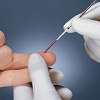
Study Examines Employer Benefits, Drawbacks of Blood-Drawing Methods
A new, free white paper "draws" upon 10 years of experience with more than 3 million blood tests to help employers choose the best method for their wellness strategy and workplace culture when it comes to taking blood from their employees or potential hires.
Titled "Health Screenings: Fingerstick or Venous Blood Draw," the paper examines the advantages and drawbacks of the two health screening methods and their respective impacts on workplace programs. The study's author, Richard Penington, president, CEO, and founder of Summit Health Inc., a Southfield, Mich.-based provider of on-site preventative wellness programs, says that companies nationwide are implementing such programs at an unprecedented rate and that while some may get queasy at the sight of blood, Summit and this study take a clear-eyed approach to the subject.
"We're often asked which is the best test method for a health screening -- the fingerstick or venous blood draw?" Penington says. "The truth is we support both methods. However, the real answer depends on the company's wellness program goals and objectives. This paper will help employers examine the differences and clear up common misperceptions."
The paper covers advantages and disadvantages involved with each method, including their respective accuracy and consistency; how they meet state and federal regulations; how they affect employee participation; and their respective return on investment (ROI) impact to wellness programs. Penington notes in the paper that while the majority of his company's clients have selected the fingerstick method for their on-site health screenings, that doesn't guarantee the approach will be the best fit for all companies.
"Employers select fingersticks almost three times more frequently than they choose venous blood draw for their on-site health screenings. One may think that fingersticks are selected more frequently because they cost less; however, that isn't necessarily true," he says. "Likewise, some believe that the venous blood draw gives results that are more accurate because the blood is sent to a lab for testing. That's also not necessarily true. . . . [F]ingerstick methods have been proven as accurate as commercial laboratory methods. We recommend one over the other based on the type of results that the employer is seeking."
To view or download the complimentary paper, go to www.summithealth.com/about_downloads.html.